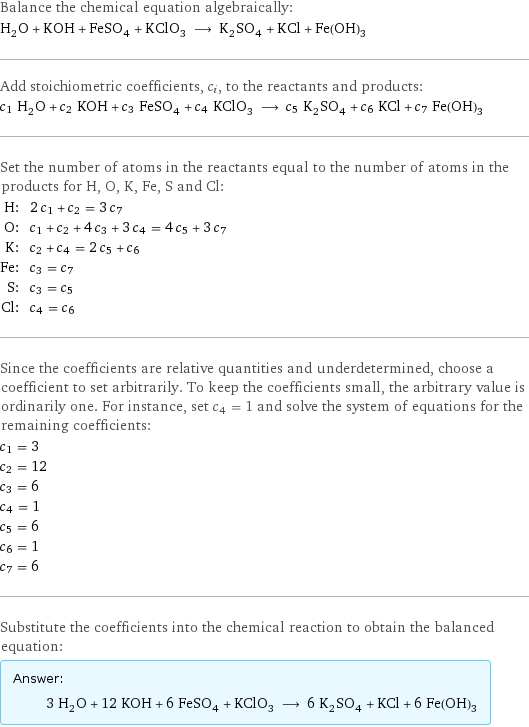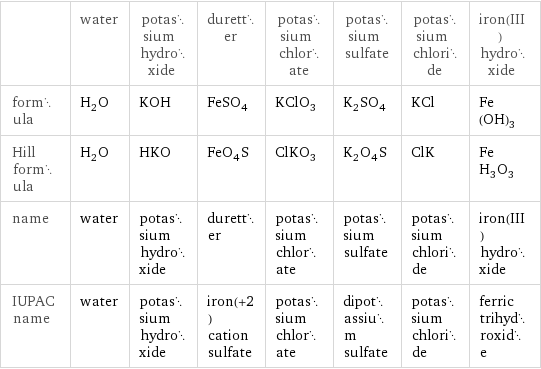Input interpretation

H_2O water + KOH potassium hydroxide + FeSO_4 duretter + KClO_3 potassium chlorate ⟶ K_2SO_4 potassium sulfate + KCl potassium chloride + Fe(OH)_3 iron(III) hydroxide
Balanced equation

Balance the chemical equation algebraically: H_2O + KOH + FeSO_4 + KClO_3 ⟶ K_2SO_4 + KCl + Fe(OH)_3 Add stoichiometric coefficients, c_i, to the reactants and products: c_1 H_2O + c_2 KOH + c_3 FeSO_4 + c_4 KClO_3 ⟶ c_5 K_2SO_4 + c_6 KCl + c_7 Fe(OH)_3 Set the number of atoms in the reactants equal to the number of atoms in the products for H, O, K, Fe, S and Cl: H: | 2 c_1 + c_2 = 3 c_7 O: | c_1 + c_2 + 4 c_3 + 3 c_4 = 4 c_5 + 3 c_7 K: | c_2 + c_4 = 2 c_5 + c_6 Fe: | c_3 = c_7 S: | c_3 = c_5 Cl: | c_4 = c_6 Since the coefficients are relative quantities and underdetermined, choose a coefficient to set arbitrarily. To keep the coefficients small, the arbitrary value is ordinarily one. For instance, set c_4 = 1 and solve the system of equations for the remaining coefficients: c_1 = 3 c_2 = 12 c_3 = 6 c_4 = 1 c_5 = 6 c_6 = 1 c_7 = 6 Substitute the coefficients into the chemical reaction to obtain the balanced equation: Answer: | | 3 H_2O + 12 KOH + 6 FeSO_4 + KClO_3 ⟶ 6 K_2SO_4 + KCl + 6 Fe(OH)_3
Names

water + potassium hydroxide + duretter + potassium chlorate ⟶ potassium sulfate + potassium chloride + iron(III) hydroxide
Equilibrium constant
![Construct the equilibrium constant, K, expression for: H_2O + KOH + FeSO_4 + KClO_3 ⟶ K_2SO_4 + KCl + Fe(OH)_3 Plan: • Balance the chemical equation. • Determine the stoichiometric numbers. • Assemble the activity expression for each chemical species. • Use the activity expressions to build the equilibrium constant expression. Write the balanced chemical equation: 3 H_2O + 12 KOH + 6 FeSO_4 + KClO_3 ⟶ 6 K_2SO_4 + KCl + 6 Fe(OH)_3 Assign stoichiometric numbers, ν_i, using the stoichiometric coefficients, c_i, from the balanced chemical equation in the following manner: ν_i = -c_i for reactants and ν_i = c_i for products: chemical species | c_i | ν_i H_2O | 3 | -3 KOH | 12 | -12 FeSO_4 | 6 | -6 KClO_3 | 1 | -1 K_2SO_4 | 6 | 6 KCl | 1 | 1 Fe(OH)_3 | 6 | 6 Assemble the activity expressions accounting for the state of matter and ν_i: chemical species | c_i | ν_i | activity expression H_2O | 3 | -3 | ([H2O])^(-3) KOH | 12 | -12 | ([KOH])^(-12) FeSO_4 | 6 | -6 | ([FeSO4])^(-6) KClO_3 | 1 | -1 | ([KClO3])^(-1) K_2SO_4 | 6 | 6 | ([K2SO4])^6 KCl | 1 | 1 | [KCl] Fe(OH)_3 | 6 | 6 | ([Fe(OH)3])^6 The equilibrium constant symbol in the concentration basis is: K_c Mulitply the activity expressions to arrive at the K_c expression: Answer: | | K_c = ([H2O])^(-3) ([KOH])^(-12) ([FeSO4])^(-6) ([KClO3])^(-1) ([K2SO4])^6 [KCl] ([Fe(OH)3])^6 = (([K2SO4])^6 [KCl] ([Fe(OH)3])^6)/(([H2O])^3 ([KOH])^12 ([FeSO4])^6 [KClO3])](../image_source/fc0465b212ffe786c5e15dee024e46f1.png)
Construct the equilibrium constant, K, expression for: H_2O + KOH + FeSO_4 + KClO_3 ⟶ K_2SO_4 + KCl + Fe(OH)_3 Plan: • Balance the chemical equation. • Determine the stoichiometric numbers. • Assemble the activity expression for each chemical species. • Use the activity expressions to build the equilibrium constant expression. Write the balanced chemical equation: 3 H_2O + 12 KOH + 6 FeSO_4 + KClO_3 ⟶ 6 K_2SO_4 + KCl + 6 Fe(OH)_3 Assign stoichiometric numbers, ν_i, using the stoichiometric coefficients, c_i, from the balanced chemical equation in the following manner: ν_i = -c_i for reactants and ν_i = c_i for products: chemical species | c_i | ν_i H_2O | 3 | -3 KOH | 12 | -12 FeSO_4 | 6 | -6 KClO_3 | 1 | -1 K_2SO_4 | 6 | 6 KCl | 1 | 1 Fe(OH)_3 | 6 | 6 Assemble the activity expressions accounting for the state of matter and ν_i: chemical species | c_i | ν_i | activity expression H_2O | 3 | -3 | ([H2O])^(-3) KOH | 12 | -12 | ([KOH])^(-12) FeSO_4 | 6 | -6 | ([FeSO4])^(-6) KClO_3 | 1 | -1 | ([KClO3])^(-1) K_2SO_4 | 6 | 6 | ([K2SO4])^6 KCl | 1 | 1 | [KCl] Fe(OH)_3 | 6 | 6 | ([Fe(OH)3])^6 The equilibrium constant symbol in the concentration basis is: K_c Mulitply the activity expressions to arrive at the K_c expression: Answer: | | K_c = ([H2O])^(-3) ([KOH])^(-12) ([FeSO4])^(-6) ([KClO3])^(-1) ([K2SO4])^6 [KCl] ([Fe(OH)3])^6 = (([K2SO4])^6 [KCl] ([Fe(OH)3])^6)/(([H2O])^3 ([KOH])^12 ([FeSO4])^6 [KClO3])
Rate of reaction
![Construct the rate of reaction expression for: H_2O + KOH + FeSO_4 + KClO_3 ⟶ K_2SO_4 + KCl + Fe(OH)_3 Plan: • Balance the chemical equation. • Determine the stoichiometric numbers. • Assemble the rate term for each chemical species. • Write the rate of reaction expression. Write the balanced chemical equation: 3 H_2O + 12 KOH + 6 FeSO_4 + KClO_3 ⟶ 6 K_2SO_4 + KCl + 6 Fe(OH)_3 Assign stoichiometric numbers, ν_i, using the stoichiometric coefficients, c_i, from the balanced chemical equation in the following manner: ν_i = -c_i for reactants and ν_i = c_i for products: chemical species | c_i | ν_i H_2O | 3 | -3 KOH | 12 | -12 FeSO_4 | 6 | -6 KClO_3 | 1 | -1 K_2SO_4 | 6 | 6 KCl | 1 | 1 Fe(OH)_3 | 6 | 6 The rate term for each chemical species, B_i, is 1/ν_i(Δ[B_i])/(Δt) where [B_i] is the amount concentration and t is time: chemical species | c_i | ν_i | rate term H_2O | 3 | -3 | -1/3 (Δ[H2O])/(Δt) KOH | 12 | -12 | -1/12 (Δ[KOH])/(Δt) FeSO_4 | 6 | -6 | -1/6 (Δ[FeSO4])/(Δt) KClO_3 | 1 | -1 | -(Δ[KClO3])/(Δt) K_2SO_4 | 6 | 6 | 1/6 (Δ[K2SO4])/(Δt) KCl | 1 | 1 | (Δ[KCl])/(Δt) Fe(OH)_3 | 6 | 6 | 1/6 (Δ[Fe(OH)3])/(Δt) (for infinitesimal rate of change, replace Δ with d) Set the rate terms equal to each other to arrive at the rate expression: Answer: | | rate = -1/3 (Δ[H2O])/(Δt) = -1/12 (Δ[KOH])/(Δt) = -1/6 (Δ[FeSO4])/(Δt) = -(Δ[KClO3])/(Δt) = 1/6 (Δ[K2SO4])/(Δt) = (Δ[KCl])/(Δt) = 1/6 (Δ[Fe(OH)3])/(Δt) (assuming constant volume and no accumulation of intermediates or side products)](../image_source/51601d543d58c15310805534082bed4b.png)
Construct the rate of reaction expression for: H_2O + KOH + FeSO_4 + KClO_3 ⟶ K_2SO_4 + KCl + Fe(OH)_3 Plan: • Balance the chemical equation. • Determine the stoichiometric numbers. • Assemble the rate term for each chemical species. • Write the rate of reaction expression. Write the balanced chemical equation: 3 H_2O + 12 KOH + 6 FeSO_4 + KClO_3 ⟶ 6 K_2SO_4 + KCl + 6 Fe(OH)_3 Assign stoichiometric numbers, ν_i, using the stoichiometric coefficients, c_i, from the balanced chemical equation in the following manner: ν_i = -c_i for reactants and ν_i = c_i for products: chemical species | c_i | ν_i H_2O | 3 | -3 KOH | 12 | -12 FeSO_4 | 6 | -6 KClO_3 | 1 | -1 K_2SO_4 | 6 | 6 KCl | 1 | 1 Fe(OH)_3 | 6 | 6 The rate term for each chemical species, B_i, is 1/ν_i(Δ[B_i])/(Δt) where [B_i] is the amount concentration and t is time: chemical species | c_i | ν_i | rate term H_2O | 3 | -3 | -1/3 (Δ[H2O])/(Δt) KOH | 12 | -12 | -1/12 (Δ[KOH])/(Δt) FeSO_4 | 6 | -6 | -1/6 (Δ[FeSO4])/(Δt) KClO_3 | 1 | -1 | -(Δ[KClO3])/(Δt) K_2SO_4 | 6 | 6 | 1/6 (Δ[K2SO4])/(Δt) KCl | 1 | 1 | (Δ[KCl])/(Δt) Fe(OH)_3 | 6 | 6 | 1/6 (Δ[Fe(OH)3])/(Δt) (for infinitesimal rate of change, replace Δ with d) Set the rate terms equal to each other to arrive at the rate expression: Answer: | | rate = -1/3 (Δ[H2O])/(Δt) = -1/12 (Δ[KOH])/(Δt) = -1/6 (Δ[FeSO4])/(Δt) = -(Δ[KClO3])/(Δt) = 1/6 (Δ[K2SO4])/(Δt) = (Δ[KCl])/(Δt) = 1/6 (Δ[Fe(OH)3])/(Δt) (assuming constant volume and no accumulation of intermediates or side products)
Chemical names and formulas

| water | potassium hydroxide | duretter | potassium chlorate | potassium sulfate | potassium chloride | iron(III) hydroxide formula | H_2O | KOH | FeSO_4 | KClO_3 | K_2SO_4 | KCl | Fe(OH)_3 Hill formula | H_2O | HKO | FeO_4S | ClKO_3 | K_2O_4S | ClK | FeH_3O_3 name | water | potassium hydroxide | duretter | potassium chlorate | potassium sulfate | potassium chloride | iron(III) hydroxide IUPAC name | water | potassium hydroxide | iron(+2) cation sulfate | potassium chlorate | dipotassium sulfate | potassium chloride | ferric trihydroxide